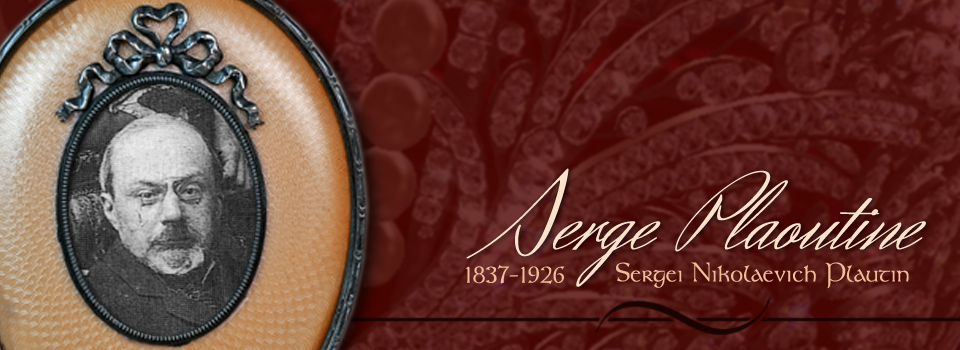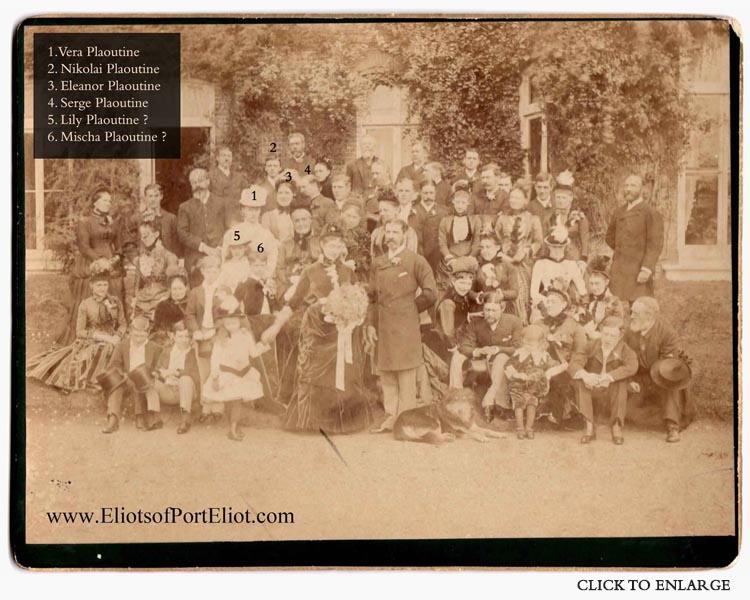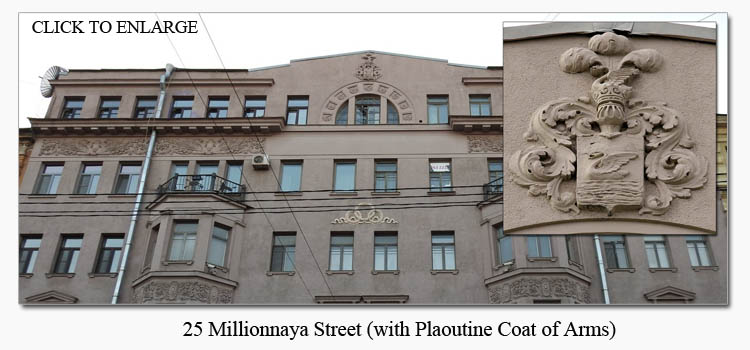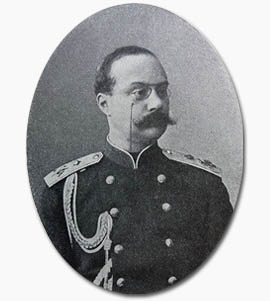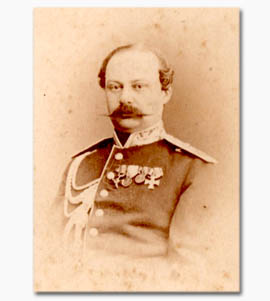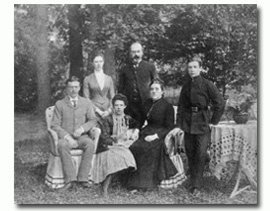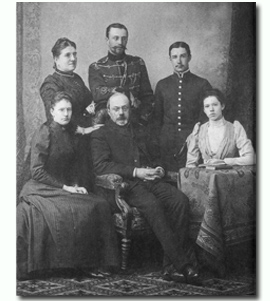Sergei Nikolaevich Plaoutine (1837 - 1926)
Sergei was the first child of Nikolai Fedorovich Plautin and Severina Iossifovna Kalinowska, known to family and friends as "Serge".
Serge Plaoutine was remembered by a young granddaughter and a niece as a sweet, gentle and "dear man, but not a typical Russian", who strongly believed in punctuality. At the time of the Communist takeover, he was also considered "one of the wealthiest land owners in the country". Through paternal inheritance and shrewd investment, he had become the owner of multiple houses and property in St. Petersburg and Tsarskoe Selo, in addition to several large estates in Central Russia (kept for the breeding of race horses). Through his mother's family, Serge later inherited vast "estates and forests in Southern Poland, a palace in Krakow, houses in Riga and other properties in Kurland". All of this came later, though, for the only son of one of the greatest Russian Generals of the 19th century (with his battle-filled and honoured record). As the times would have demanded in his younger days, Serge followed in the footsteps of his father and became an officer in the Russian Army. While it is known that he did achieve the rank of Lieutenant General before retirement, little else has surfaced about Serge's career. A treasured family photo, dated 1875, shows him in his Army uniform, proudly displaying four medals on his chest. Two of them are the Knight of the Order of St. Vladimir and the Prussian Order of the Red Eagle, the other two yet to be identified. Serge served as Major-General of his Majesty's Suite for many years, during which time he earned the great esteem of Tsar Alexander II. In 1883, at the young age of forty-six years, Serge retired with the honor of having served as "Aide-de-Camp to His Majesty the Tsar" through two reigns (those of Alexander II and Alexander III).
Nothing is known of Serge's childhood and youth, but he may have been the Russian officer (whose signature was a simple "Plaoutine") arriving in London in 1858 aboard the Triton from Calais. France was the choice holiday destination for many Russians in those days, and it was in Nice that Serge's father actually passed away in January of 1867 (though his remains were returned to Russia, where he was buried in the church near the family's beloved home in Tsarskoye Selo). This is where we pick up the thread of Serge's story. Thirty years old, having buried his only Sister and their Father in less than twelve months (his Mother having passed away fifteen years before), he found himself deprived of the covering and joy attendant on family life.
Enter Miss Eleanor Pringle. They say that "time heals", but time worked quickly here and, four months later, Colonel Serge Plaoutine married one of "the reigning blonde beauties of London", second daughter of Lt Colonel John Henry Pringle of the Coldstream Guards. They married in Nice and settled for a time at Number 11 Rue Gioffredo. Shortly after the birth of their first son, Nikolai (just nine months after the wedding), they returned to Russia, where their family continued to grow.
The Plaoutines circulated in the highest society St. Petersburg had to offer and were on intimate terms with myriad members of the Tsar's Court. Much of their time was spent in the city, at their home at 24 Quai de la Cour (also known as the Winter Palace Embankment), which stood beside the palace of Grand Duke Vladimir and opposite the St. Peter and Paul Cathedral. This grand mansion house was very large and unique in that it was what is often referred to as a "double front" – stretching from Quai de la Cour, through the back, to the next street – giving Serge and Eleanor a second address at 25 Millionnaya Street. One house, two addresses.* For the periods when city life was less than desirable, the family owned a country estate at Tsarskoe-Selo (called a Dacha), a quick forty-five-minute journey from St. Petersburg. For years to come, this was the place for extended family gatherings, and children were proud to pose with their playthings for photos which commemorate those happy times. Cousins would fondly remember these days for the rest of their lives.
Needs must, however, and change came to the family in May of 1883, with the retirement of Lieutenant-General Serge Plaoutine from active duty in the Russian Army and his post as A.D.C. to the Tsar. The decision to enroll their oldest son at Brighton College necessitated a move of residence to England for the next three years. Serge rented a flat at 47 Marine-parade in Brighton, and it was there that the family enjoyed what his youngest daughter Lily called "four of the happiest years". It had the added (and no less important) bonus of providing them with many opportunities to enjoy their Mother's large English circle of relations. Nikolai left Brighton College in 1886, and the family returned to Russia, ever after maintaining a close relationship with Eleanor's family in England.
Retirement offered other benefits as well, and Serge was now able to indulge his keen interest in Ornithology. He became well known for his very large collection of mounted birds, many of which were very rare specimens. (The entire collection was left in Russia and confiscated or destroyed by the Communists.) Passionate and well informed, his comments and observations on different species were published in various European magazines. He also inspired one of his grandsons, Michael Plaoutine, to begin his own extensive collection of rare birds' eggs and nests, which too became the property of the Red regime.
Together, Serge and his wife shared an avid interest in Paleontology, and they discovered a number of new species of fossilized animals, all now called "Plautini" in their honour. One species of a fossilized echinoderm first discovered and named by Eleanor was the Cyathocystis plautinae, Schmidt, 1879. Serge and Eleanor also discovered a number of new species of Russian trilobites (most, if not all, seem to have come from the St. Petersburg area), among them:
Reraspis plautini (Schmidt, 1881)
Hoplolichas plautini (1885)
Illaenus plautini (Holm, 1886)
Harpides plautini (Schmidt, 1894)
Asaphus plautini (Schmidt, 1901)
Paraptychopyge plautini (Schmidt, 1904)
Brachytomaria plautini (Koken et Perner, 1925)
Serge's other passion was art, which he enjoyed viewing and collecting. He frequented the small curio and pawn shops in St. Petersburg, always on the look-out for some addition to his own growing collection. He also spent many days and hours in the larger Italian museums. Customarily, the Plaoutines spent much of the winter travelling to more temperate climes (because of the disagreeably cold and wet climate in so many areas of Russia). As their children grew up and grandchildren entered the family circle, the location for these family trips varied to include Menton, Florence, Saltino and Nice. The latter was so favored by all that, at some time around 1907, Serge permanently leased a flat (being the entire second floor) at the Chateau St. Laurent.
During the winter of 1909-10, Serge and Eleanor rented a house in Florence, Italy. They were joined by their youngest daughter (Lily) and her family, as well as by Eleanor's younger sister and niece (Blanche and Eleanor Violet Jauncey). Seventy years later, the younger ones would remember those months as some of the happiest the family ever spent together. Serge often indulged his keen interest in art by visiting Museums, which engendered a dear and lifetime friendship between him and his nineteen-year-old niece, Eleanor Jauncey. She necessarily accompanied him on these outings, since he "could not read the explanations and names of all the exhibits, which were extremely interesting but too small for his failing eyesight." Eleanor Violet treasured fond memories of these visits and credited them with nurturing a love of Art which lasted the rest of her life.
In 1914, Serge and Eleanor Plaoutine moved to their flat at Chateau St. Laurent, leaving Russia for what would be the last time, little guessing that his quiet retirement to Nice would become a permanent exile from the country which he loved so dearly.
Serge now had to cope with not only dim eyesight, but his hearing failed in about 1917 (around his 80th birthday). His young granddaughter remembered having to speak to him through a mouthpiece. His habit of reading the newspapers every day, not to be abandoned just because he couldn't see them anymore, created employment for two women who came on alternate days – one read the Russian papers to him, the other the English. Thus, Serge and Eleanor continued their life together for three more years.

The world-at-large was fighting the "War to End All Wars". King George V of England changed the royal family's surname to "Windsor". The Mexican Revolution was in full swing. And Russia . . . In 1917, the Communists perpetrated atrocities equalled only by the Nazis in a later war. The Revolution brought massive changes to all Russians, and none of them for the better. When Serge left Russia in 1914, he made a conscious decision to leave his money where it belonged – in Russia, which he considered to be a young country with a future. He judiciously left his estate and extensive Russian properties under the management numerous stewards, overseen by his younger son, Mischa, who sent regular payments to his parents in France. Then, 1917. Sadly, on the day that the Bolsheviks came into power, the flow of money stopped abruptly. The aged General and his wife were left with no cash income and only the few treasures which they had brought with them, consisting of "a couple of pictures, some Russian coins and a few French bronzes". Serge sold each piece off, one by one, and the once-again-large family (Serge and Eleanor were now raising three young granddaughters who had been hastily removed from harm's way in Russia) would have been left penniless "without the very kind gesture" of Ronald Lindsay, British Ambassador in Washington and distant cousin of Eleanor Plaoutine.
Serge's final years were unbearably lonely and sad, filled with long, empty days of waiting and wondering. By 1921, all four of his children had died – the two oldest from disease, the two youngest brutally murdered by the Bolsheviks – although it's unlikely that the parents actually knew what had happened in every case, left to wonder in fear. Many of his grandchildren had also been murdered, some were missing, others had escaped to other parts of Russia under new names and never again contacted any of their remaining family, and the three little girls were grown now and had moved on to take their own places in the world. He had neither the money nor the health to pursue his outside interests, and the Lieutenant-General and his beautiful wife lived out their remaining days in obscurity. In 1924, after fifty-seven years of marriage and seven years of wondering when the horrors would end, Eleanor passed away; and Serge was left at Chateau St. Laurent with a loyal servant to care for him. He survived his wife by almost two years before dying "of loneliness and old age." In what must have been a small and quiet funeral, Serge was laid to rest with Eleanor at Ste Marguerite Anglo Cemetery in Nice, France, where a large flat stone (with a cross and a deteriorating inscription) still marks the spot of their final resting place.
Requiesce in pace.

*The house at 24 Quai de la Cour/25 Millionnaya St. was most likely purchased by Serge in the 1870s, appearing much the same as it looks today, having been built in 1859-60 by the architect Gustav M. Barch on the site of an earlier two-story building. It is unclear whether it was originally built as one home connecting to both streets or whether it was two homes which were later joined. When the Plaoutine family moved into the mansion, the Quai de la Cour side was four stories high with a Neo-Baroque facade, almost identical to that seen on the building today. Then, in 1901, Serge Plaoutine employed the architect S.S. Smirnov to rebuild renovate the house by adding a fifth story, making it the tallest building in the Palace Embankment area – even taller than the Winter Palace itself for a short time. Despite adding the extra story, however, the architect laudably managed to maintain the original facade. In fact, the front of the building was so little changed that the difference is not easily noticeable. The most practical aspect of this reconstruction was the fact that the house was changed into an "apartment house", and it was around this time that the Millionnaya Street side was given to Mischa and Vera (son and daughter). Mischa and his family lived for a time in the top-floor flat, and Vera's family appears in City Directories under that address (and may or may not have ever lived in the house). More renovations took place in 1908 under the architect N.V. Trusov, when "engineering communications" (possibly a poor translation of the original Russian) were updated and service buildings were added in the courtyard. Serge ordered a reconstruction of the Millionnaya Street front in 1913, just before his final retirement to Nice, and the Plaoutine family Coat of Arms can still be seen at the top of the building.
Aside from their personal residences, Serge also controlled massive properties throughout Russia and Poland until 1917, having bought and sold various properties throughout his life. He was recorded as the owner of a house at 25 Moshkov Lane. In 1885, at a public auction, he purchased a large house in St. Petersburg at 32 Mokhovaya Street, but the deed was transferred to a Major-General V.K. Guager in 1894. As Russian documents become available to researchers, more properties are likely to appear.

Serge paid to have a Coat of Arms (featuring a floating swan crest) created by the Russian Department of Heraldry, where they were developed by the Herald Master Barsukov and finally approved on 11 Jun 1894. Just why the floating swan was chosen (being a crest belonging to the Plowin family) is recorded in a document, apparently surviving in some kind of records belonging to the Department of Heraldry, stating that the Plautins had "from time immemorial put it on the family seals of the family." This is believed to be a slight stretching of the truth, as the saying goes, but it stands as the only piece of evidence in the case. Apparently, the desire to depict the swan on the coat of arms manifested itself around 1892, at the time of the marriage of Serge and Eleanor's oldest son, Nikolai, to Maria Raevskaya. The Raevskaya family was truly ancient and possessed a Coat of Arms as ancient as their pedigree. Certainly, the Plautin family managed to trace their lineage all the way to Klementi Plautin in the beginning of the 15th century, but they could produce no physical evidence of a prior use of crest or arms.

Misc. Notes:
— "Nouveaux mémoires de la Société impériale des naturalistes de Moscou", Volume 15, 1898, page 153:
[Serge Plaoutine's observation on the development of some types of birds.]
Quant a l'independance de cet albinisme partiel des variations d'age, je puis encore remarquer que je l'ai ovserve sur des individus en diverses livrees imparfaites, a partir de la premiere mue, sans y trouver autre chose que des differences individuelles, les rectrices et autres plumes fraiches ayant invariablement autant de blanc que celles qu'elles remplacent, et de tres jeunes individus ayant moins de blanc que certains adultes. Ainsi us jeune dans sa premiere mue 3) a les rectrices, et fraiches et usees, en partie normales, en partie a base et bandes trausverses, ondulees, blanches sur le pennon interne largement borde de blanc vers la base, sur 1/3 - 1/2 de leur longueur; pas moins de blanc sur les rectrices fraiches que sur les vieilles.
— "England, Alien Arrivals, 1810-1811, 1826-1869":
Name: Plaoutine
Port of Arrival: London, England
Arrival Date: 10 May 1858
Port of Departure: Calais, France
Ship: Triton
Country of Origin/Native of: Russia
